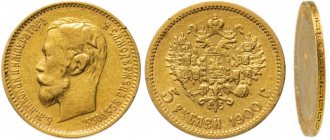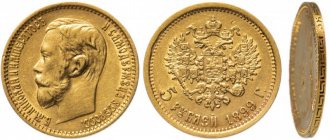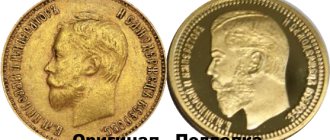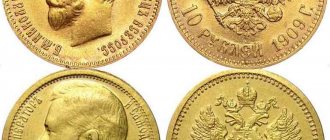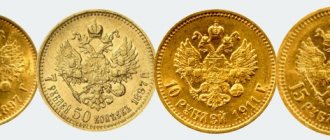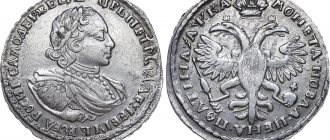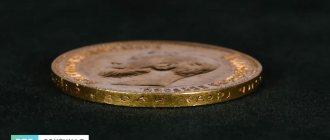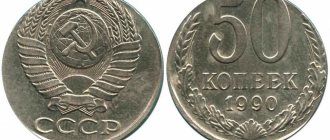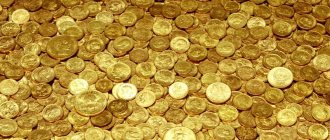Good day, dear guests and subscribers. Today we will talk about a special collectible, or rather, donative Nikolaev coin - 2.5 imperials, or 25 rubles, issued in 1896. The price offered for 25 rubles 1896 (gold) is simply exorbitant. The cost per copy of the lowest degree of preservation starts from a million. Why collectors are willing to pay such a price, what this commemorative coin is famous for, what sums have been paid for it in recent years - I will tell you right now.
The Last Emperor: From the History of a Great Country
The reign of Emperor Nicholas II took place from 1894 to 1917 – difficult and controversial years for the people and the country as a whole. Nicholas II became the last emperor, and with him a great era that lasted more than three hundred years sank into oblivion.
On the eve of the First World War and the October Revolution, Russia reached its peak and was one of the most powerful powers in the world. Military affairs, mechanical engineering, oil and metallurgical industries were actively developing. All this, naturally, entailed the development of coin production. At that time, the St. Petersburg Mint functioned in the empire, where all the banknotes of the empire were minted. And there was something to mint: kopecks (1/4, ½, 1, 2, 3, 5, 10, 15, 25, 50), rubles (ruble, 5, 7.5, 10, 15, 25). Copper, silver and gold coins were issued.
Witte's monetary reform of 1897
This reform was carried out by Emperor Nicholas II in 1895–1897. This was prepared under Alexander II and Alexander III, but it was carried out fully and thoughtfully under the last Russian emperor. She established the gold standard of the ruble and brought it to the level of a world currency. New coins have appeared in denominations of 15 rubles and 7 rubles 50 kopecks. The reform was carried out by the Minister of Finance S.Yu. Witte and made it possible to significantly improve the state of the economy in the country. Historians, having analyzed many reforms, consider it one of the most successful in the history of the tsarist state. Thanks to the strengthened position of the Russian Empire on the world stage, the reform was carefully prepared and thought through. It took place in several stages and lasted for several years. It is likely that if Russia had not been drawn into World War I, it would have become a leading world power with a strong economy, a stable ruble and advanced monetary policy.
Copper coins of Nicholas II
As a result of the monetary reform, copper, silver and gold banknotes were put into use. In addition, a trial version of an aluminum coin with a face value of 5 rubles was released.
Copper coins included specimens in denominations of 1/4, ½, 1, 2, 3, 5 kopecks. These coins, as the basis of monetary relations, were used for small payments and small monetary transactions. Their model was established in the middle of the 19th century (1860s), they were produced in multi-million copies until the fateful 1917. They are of the least interest and value (large circulations, so you can find them more often than analogues of the same period). However, among copper coins there are rare options - for example, half a kopeck and a quarter of a kopeck, which were minted in 1894, and coins in denominations of 3 kopecks and 5 kopecks, which appeared in 1917.
Copper coins were issued at the St. Petersburg Mint (“S.P.B.” - this was the sign of this yard; it was marked on all copies until 1914, after which the place of minting was no longer indicated), as well as in Great Britain - at the Birmingham Mint yard At the turn of the century, there was another private coin mint, which was also located in the Northern capital.
With coins made from this material you could buy a loaf of bread - it cost from 3 to 5 kopecks, milk (1 bottle) - up to 10 kopecks, drink beer (1 glass) - 6 kopecks. or a glass of vodka – 7 kopecks. Moreover, the average salary of a joiner or carpenter was about 2-3 rubles a day, and for a day laborer it did not exceed a ruble, while women received even less.
The external design of the copper coins is simple and has much in common with the design of such coins that were issued in previous years. The reverse depicted the denomination, the year of issue, the mint was noted (regardless of the place of production, “S.P.B.” was always indicated), two small five-pointed stars were also depicted on the sides of the denomination and decorative monograms in the center of the coin.
Rare copper coins of Nicholas II
The rarest are the ¼ and ½ kopecks from 1894, which were minted before the coronation of Nicholas. Apparently, their circulation was very small, and today the price for these copies can be $1,000 apiece.
Coins with a face value of 5 kopecks, which were issued in 1916, are also considered expensive and valuable. The 1917 mintage is considered rare and very expensive, since these coins were not put into circulation.
Silver coins of Nicholas II
Under Nicholas II, silver coins were issued in denominations of 5, 10, 15, 20, 25, 50 kopecks, 1 ruble.
It is worth noting that now the emperor’s profile, located on the obverse of the coin, was positioned to the left (the coins that were minted under Alexander III were of a different design - there the emperor’s profile was turned to the right). On the silver 25 and 50 kopecks, as well as on the obverse of the silver ruble, the profile of the emperor was depicted by Vasyutinsky. The reverse of the coin featured the crest of the Russian Empire (a double-headed eagle crowned with a crown, holding a scepter and orb - symbols of royal power), the denomination of the coin, the year and place of issue were indicated.
Some silver coins were minted by the Paris and Brussels mints. Since all coins have o, it is difficult to determine the exact place of minting, but this can be done by the edge - Paris has one star, and Brussels has two.
Throughout the issue of silver coins of Nicholas II, the image of the coat of arms did not change significantly, while the image of the emperor’s profile on coins of 1912–1913 was more convex than on copies of other years. In general, over the twenty-year period of issue of Nicholas coins, five variants of portrait forms of the last emperor can be found.
Appearance and Design
Donative banknotes made of gold did not differ in any special style of design in comparison with the common means of payment in Tsarist Russia. You can see this for yourself by looking at the sample photo.
Obverse
The obverse side of the 1896 gold 25 ruble is an elaborate imperial profile, surrounded by two semicircular inscriptions indicating the name and official title of the Tsar.
Reverse
The reverse side of the commemorative coin made of precious metal is decorated along the entire circumference with an inscription indicating both denominations - 25 rubles in gold, 2 ½ imperial 1896.
Inside the circle is the official symbol of the Russian Empire, which is a double-headed eagle with the attributes of royal power - a scepter, an orb and three crowns.
edge
On the edge 25 rubles. 1896, the letters are engraved: “Pure gold 6 spools 77.4 shares.” The inscription ends with a five-pointed star.
Rare silver coins of Nicholas II
These include the commemorative coronation ruble, which was issued in 1896 and dedicated to the coronation of Nicholas II. According to scientists, this coronation brought many victims: a huge crowd gathered on the Khodynskoye field, as a result of which many were simply crushed (about 1,500 dead and 1,000 injured). Of course, everyone wanted to see the coronation and receive the promised gifts, food and a commemorative ruble. As a result, this desire became fatal for someone. Today the price of this rare coin is about $200.
Another rare silver coin is the anniversary ruble. It was released in 1912 in a small edition of about 40,000 pieces to mark the centenary of the victory over Napoleon. The average price for this coin today is about $300, and the maximum can reach up to $5,000 if in good condition.
History of appearance
The very tradition of issuing anniversary currency units made of gold and silver, timed to coincide with certain important events, was adopted by the Russian monarchs from the French. In 1895, on the eve of the most important event for any monarch - the coronation, Nicholas II's cousin, Grand Duke Vladimir Alexandrovich, ordered 300 gold pieces. They had a double denomination - 25 rubles or 2.5 imperials - and were intended for gifts to nobles.
Emperor Nicholas 2 received one hundred pieces as a gift, the remaining two hundred gold pieces remained with the customer. Another one, the 301st coin, was made in 1899 by personal order of another uncle and part-time son-in-law of the emperor, Grand Duke Alexander Mikhailovich. Presumably, the same stamps were used as for the main batch.
Gold coins of Nicholas II
Gold coins were issued in denominations of 5 rubles, 7 rubles 50 kopecks, 10, 15, 25 rubles. Gold coins with a denomination of 100 francs (37.5 rubles) were also minted.
Initially, the weight of gold coins was large, but later it was reduced to replenish the state treasury (the weight of the coin reached 13 g, and became 9 g). For example, a coin with a face value of 5 rubles was initially minted in a small weight. The design of gold coins is not much different from copper and silver coins: the obverse depicts a portrait of Nicholas II facing left (west), and the reverse shows the coat of arms of the Russian Empire, the denomination of the coin, the year and place of issue.
Where can you buy or sell
Due to the fact that the coin is incredibly rare, the only way to sell or buy one of its copies today is through an auction. Auction houses specializing in numismatic items guarantee the authenticity of the specimens put up for auction. Recent transactions for the purchase and sale of 25 gold rubles from the 1896 model were recorded at the following auctions: Wolmar VIP, RusNumismat, Numismat.ru.
The prices in the table are current as of 2021 (date of last registered passage). It is unknown how much such a coin is worth today.
Price table depending on condition
| Condition/name | F price | VF price | XF price | AU price | UNC price | Proof price |
| 25 rubles, 2 ½ imperials 1896, gold | 1 150 000 | 3 180 409 | 3 237 500 | 3 835 004 | 8 821 873 | 4 269 121 |
Rare gold coins of Nicholas II
Rare gold coins of this period can safely include imperials (coins with a face value of 10 rubles) and semi-imperials (coins with a face value of 5 rubles). These coins were issued only for three years - from 1895 to 1897. They were required to have the inscription “imperial” stamped on them. On average, up to 130 pieces of imperials and up to 40 pieces of semi-imperials were issued per year. All of them had great weight (as under Alexander III). Other coins of the same denominations were already issued in “lightweight” form. Today the price for them can reach $50,000.
Among numismatists and collectors, gift coins in denomination of 25 rubles and gold one hundred francs are also valued. The first ones were minted in 1896 - for the coronation of Nicholas II and in 1908 - for the 40th anniversary of the Tsar. Today such coins can cost about 150-170 thousand dollars. One hundred francs is a very unusual coin for the Russian state. It corresponded to 37.5 rubles, and may have received its name to strengthen Franco-Russian relations, or for use in casinos. Today its price on the market is about 150 thousand dollars.
Coin 25 rubles 1896 2 and 1/2 imperial Gold in memory of the coronation of Nicholas 2
Another gold coin with a face value of 25 rubles was ordered by Grand Duke Alexander Mikhailovich in 1899. Based on this, the total circulation of the Coronation gift gold coin was 301 copies.
The fact that there is an image of one star on the edge of the coin has caused a lot of controversy among some historians. The record of the archivist of the Mint in St. Petersburg M.I. Smirnov is questioned, in which he claims that gold mugs in denominations of twenty-five rubles were produced at the St. Petersburg Mint, and then a batch of 300 copies of gold coins with a denomination was minted there in 1895 at 25 rubles. However, everything seems to be that due to a lack of capacity at the St. Petersburg mint at that time, the production of coins was ordered from the mints of Paris, Brussels and small coins in Japan. The mint in Paris put one star on the coins it minted, but the mint in Brussels put two stars on the coins. This allows us to conclude that 25 rubles 1896 Coronation was minted in Paris and precisely in 1896.
The imperial gold commemorative coin of 1896, with a face value of 25 rubles, is sometimes not indicated in catalogs of coins that were in circulation, and along with other denotative coins, their description is placed in a separate section. This speaks primarily of the exceptional value of this item.
An analogue of the Imperial Coronation coin was issued in 1908 in connection with the 40th anniversary of Tsar Nicholas II. The 25 ruble coin of 1908 was an actual copy of the gold 25 ruble coin of 1896. The only discrepancy between these coins was the minting date; the last one had the date 1908.
But by the time the anniversary coin was issued, it no longer corresponded to the coin stack in which the “Coronation” coin was produced, since in 1897 a reform was carried out and the stack changed, and this indicates that the 25 ruble belonged to the donated gift coins. The first edition of 150 copies was made from a gold nugget weighing about five kilograms, which was found in the royal mines.
This coin had a repeat circulation in 1910, the customer was Grand Duke Georgy Mikhailovich, in total, in the second circulation, 25 pieces of gold gift coins were produced.
Nowadays, all imperial gold gift coins with a face value of 25 rubles minted during the reign of Nicholas II are very rare and very expensive. Even if a counterfeit coin of 25 rubles of 1896 Imperial in memory of the Coronation of Nicholas 2 appears in front of a numismatist, this will not in any way reduce interest in it. View a QUALITY copy of 25 rubles 1896 Imperial in the online store
